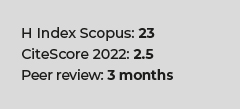Characteristics of the high ioduria concentrations in schoolchildren and adolescents in Colombia
DOI:
https://doi.org/10.17843/rpmesp.2021.381.5793Keywords:
Iodine in urine, Iodine deficiency, Excess iodine, SchoolchildrenAbstract
Objetives. To determine the characteristics of high ioduria concentrations in schoolchildren and adolescents in Colombia. Materials and methods. Secondary analysis of the 2015 National Survey of the Nutritional Situation in Colombia in participants aged 5 to 17 years, which included the measurement of ioduria. The
criteria to measure the nutritional status of iodine were based on the median urinary iodine concentration in μg / L defined by the World Health Organization (WHO), where values <100 are considered deficient, between 100-199 adequate, 200-299 above the requirements and> 300 excessive. Odds ratio measurements were also performed through logistic regression analysis. Results. The national median iodine for schoolchildren and adolescents was 406.8 μg / L and 410.8 μg / L respectively, higher in the urban area (410.5 μg / L), in the
Atlantic region the highest level was found for schoolchildren (423.7 μg / L) and in the central for adolescents (427.7 μg / L). 4.4% of schoolchildren and 2.2% of adolescents presented deficiency and in more than 75% of the population, there was excessive intake of iodine. The factors associated with excessive iodine intake in schoolchildren were age, ethnicity, region and wealth index, and for adolescents gender and geographic area. Conclusions. The iodine concentrations in Colombian schoolchildren and adolescents are higher than adequate according to WHO, the deficiency is very low and a serious public health problem occurs due to excessive iodine intake in three-quarters of the population.
Downloads
Downloads
Published
Issue
Section
License
Copyright (c) 2021 Revista Peruana de Medicina Experimental y Salud Pública

This work is licensed under a Creative Commons Attribution 4.0 International License.


























